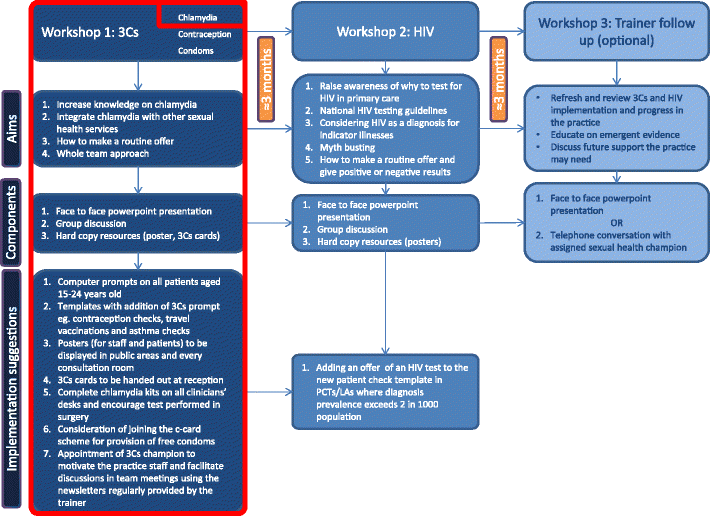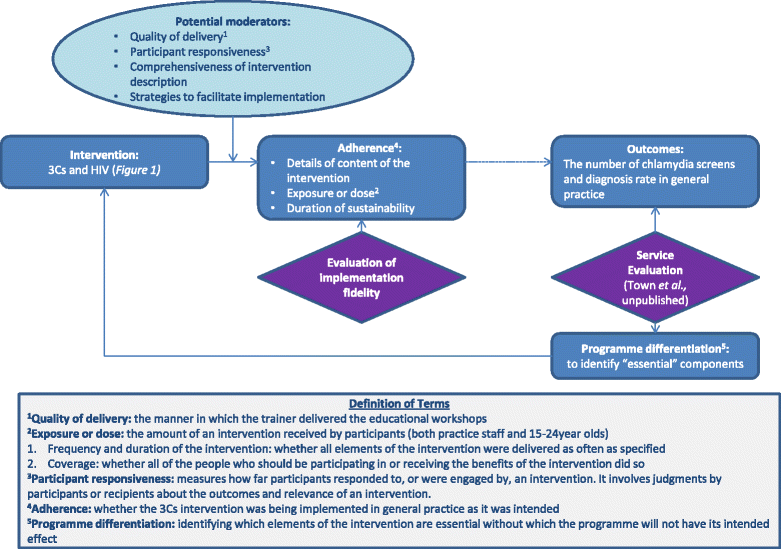Exploring why a complex intervention piloted in general practices did not result in an increase in chlamydia screening and diagnosis: a qualitative evaluation using the fidelity of implementation model
- PMID: 28327096
- PMCID: PMC5361828
- DOI: 10.1186/s12875-017-0618-0
Exploring why a complex intervention piloted in general practices did not result in an increase in chlamydia screening and diagnosis: a qualitative evaluation using the fidelity of implementation model
Abstract
Background: Chlamydia trachomatis (chlamydia) is the most commonly diagnosed sexually transmitted infection (STI) in England; approximately 70% of diagnoses are in sexually active young adults aged under 25. To facilitate opportunistic chlamydia screening in general practice, a complex intervention, based on a previously successful Chlamydia Intervention Randomised Trial (CIRT), was piloted in England. The modified intervention (3Cs and HIV) aimed to encourage general practice staff to routinely offer chlamydia testing to all 15-24 year olds regardless of the type of consultation. However, when the 3Cs (chlamydia screening, signposting to contraceptive services, free condoms) and HIV was offered to a large number of general practitioner (GP) surgeries across England, chlamydia screening was not significantly increased. This qualitative evaluation addresses the following aims: a) Explore why the modified intervention did not increase screening across all general practices. b) Suggest recommendations for future intervention implementation.
Methods: Phone interviews were carried out with 26 practice staff, at least 5 months after their initial educational workshop, exploring their opinions on the workshop and intervention implementation in the real world setting. Interview transcripts were thematically analysed and further examined using the fidelity of implementation model.
Results: Participants who attended had a positive attitude towards the workshops, but attendee numbers were low. Often, the intervention content, as detailed in the educational workshops, was not adhered to: practice staff were unaware of any on-going trainer support; computer prompts were only added to the female contraception template; patients were not encouraged to complete the test immediately; complete chlamydia kits were not always readily available to the clinicians; and videos and posters were not utilised. Staff reported that financial incentives, themselves, were not a motivator; competing priorities and time were identified as major barriers.
Conclusion: Not adhering to the exact intervention model may explain the lack of significant increases in chlamydia screening. To increase fidelity of implementation outside of Randomised Controlled Trial (RCT) conditions, and consequently, improve likelihood of increased screening, future public health interventions in general practices need to have: more specific action planning within the educational workshop; computer prompts added to systems and used; all staff attending the workshop; and on-going practice staff support with feedback of progress on screening and diagnosis rates fed back to all staff.
Keywords: Adherence; Chlamydia; Educational intervention; Evaluation; Fidelity; General practice; Implementation; Qualitative; Testing; Training.
Figures



Similar articles
-
Chlamydia and HIV testing, contraception advice, and free condoms offered in general practice: a qualitative interview study of young adults' perceptions of this initiative.Br J Gen Pract. 2017 Jul;67(660):e490-e500. doi: 10.3399/bjgp17X691325. Epub 2017 May 22. Br J Gen Pract. 2017. PMID: 28533198 Free PMC article.
-
Service evaluation of an educational intervention to improve sexual health services in primary care implemented using a step-wedge design: analysis of chlamydia testing and diagnosis rate changes.BMC Public Health. 2016 Aug 2;16:686. doi: 10.1186/s12889-016-3343-z. BMC Public Health. 2016. PMID: 27484823 Free PMC article. Clinical Trial.
-
Qualitative interviews with healthcare staff in four European countries to inform adaptation of an intervention to increase chlamydia testing.BMJ Open. 2017 Sep 25;7(9):e017528. doi: 10.1136/bmjopen-2017-017528. BMJ Open. 2017. PMID: 28951413 Free PMC article.
-
Chlamydia detection and management.Aust Fam Physician. 2000 Jun;29(6):522-6. Aust Fam Physician. 2000. PMID: 10863806 Review.
-
Application of the COM-B model to barriers and facilitators to chlamydia testing in general practice for young people and primary care practitioners: a systematic review.Implement Sci. 2018 Oct 22;13(1):130. doi: 10.1186/s13012-018-0821-y. Implement Sci. 2018. PMID: 30348165 Free PMC article.
Cited by
-
Qualitative impact assessment of an educational workshop on primary care practitioner attitudes to NICE HIV testing guidelines.BJGP Open. 2018 Apr 7;2(1):bjgpopen18X101433. doi: 10.3399/bjgpopen18X101433. eCollection 2018 Apr. BJGP Open. 2018. PMID: 30564709 Free PMC article.
-
Pooled prevalence and determinants of modern contraceptive utilization in East Africa: A Multi-country Analysis of recent Demographic and Health Surveys.PLoS One. 2021 Mar 18;16(3):e0247992. doi: 10.1371/journal.pone.0247992. eCollection 2021. PLoS One. 2021. PMID: 33735305 Free PMC article.
-
Long term effect of primary health care training on HIV testing: A quasi-experimental evaluation of the Sexual Health in Practice (SHIP) intervention.PLoS One. 2018 Aug 1;13(8):e0199891. doi: 10.1371/journal.pone.0199891. eCollection 2018. PLoS One. 2018. PMID: 30067778 Free PMC article.
-
Fidelity of the delivery of NHS Health Checks in general practice: an observational study.BJGP Open. 2020 Oct 27;4(4):bjgpopen20X101077. doi: 10.3399/bjgpopen20X101077. Print 2020 Oct. BJGP Open. 2020. PMID: 32967842 Free PMC article.
-
Laboratory Detection of First and Repeat Chlamydia Cases Influenced by Testing Patterns: A Population-Based Study.Microbiol Insights. 2019 Feb 27;12:1178636119827975. doi: 10.1177/1178636119827975. eCollection 2019. Microbiol Insights. 2019. PMID: 30833813 Free PMC article.
References
-
- Public Health England . Sexually transmitted infections and chlamydia screening in England, 2014. 2015.
MeSH terms
LinkOut - more resources
Full Text Sources
Other Literature Sources
Medical
Molecular Biology Databases

